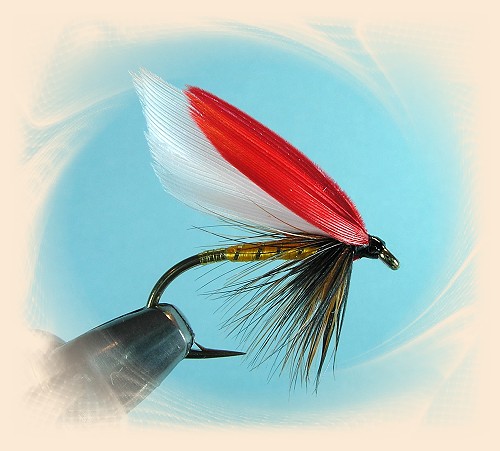This week I bring you a fly developed right here in
Columbus, Ohio. It was a local fly, used in the area
in the 1800s to entice "black bass" in the warm water
rivers that abound in Central Ohio. We know these fish
as smallmouth today.
Hugh Hardy, a Columbus resident, made this fly known to
us in a letter sent to Mary Orvis Marbury, included in
her book Favorite Flies and Their Histories.
He mentions several well-known flies for bass that worked
well in the area, and then goes on to say:
"You will know all the flies I have mentioned except
the Chippy, probably. This fly was gotten up by Colonel Park,
of this city, and several fishermen helped him name it Chippy,
because it looks so giddy. It has an orange-yellow body, with
a narrow band of gold tinsel; black hackle at head, and white
wings, covered partly by red wings. Its combination of color
has proven a killing fly, especially for large trout in
Northern waters."
We still have some great smallmouth fishing in Columbus to
this day. Mr. Hardy mentions seven natural black bass streams
in the area that provided good fishing 150 years ago, and that
is the case today as well. Yes, the streams have been dammed,
and reservoirs installed, and some of the fishing has changed
from river fishing to lake fishing, but the smallmouth remain
and thrive. As with multi-use waterways everywhere, things
aren't as perfect as the fly fishermen would like them to be.
We have problems with industrial pollution, farm runoff, and
flows, as is the case everywhere. The Olentangy River in Delaware
and Columbus is a perfect case in point. When it's right, the
Olentangy is as beautiful a river as you've ever seen. Each
summer however, in times of drought especially, the river goes
down to a trickle as the dam is controlled to keep water levels
up in the reservoir. High water levels in the reservoir makes
the water skiers, swimmers, lake fishermen, and farmers happy,
but makes the fly fishermen rather unhappy. I think though that
we as fly fishers can't have everything the way we want it all
of the time. The best any of us can hope for is a happy compromise
in these situations, one that makes everyone a little happy, and
leaves nobody out. It is called 'multiple use.'
Well, that's as political as I'll ever get in this column.
I'm more interested in the flies and the fishing I guess.
Here's the recipe for the Chippy:
Chippy:
Tip: Gold tinnsel.
Hook: Mustad 9672, or equivalent, size 4-6.
Body: Yellow-orange floss.
Rib: Thin gold tinsel.
Wing: White under-wing, partically veiled by a red
over wing.
Credits: Favorite Flies and Their Histories
by Mary Orvis Marbury. ~ Eric Austin
|

